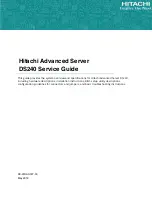
v
Reboot/Restart Policy Setup Menu
The following menu controls the Reboot/Restart Policy:
Reboot/Restart Policy Setup Menu
1. Number of reboot attempts:
Currently 1
2. Use OS-Defined restart policy?
Currently No
3. Enable supplemental restart policy?
Currently Yes
4. Call-Out before restart:
Currently Disabled
98. Return to Previous Menu
0>
Reboot
is the process of bringing up the system hardware; for example, from a system reset or power
on.
Restart
is activating the operating system after the system hardware is reinitialized. Restart must
follow a successful reboot.
–
Number of reboot attempts
- If the system fails to successfully complete the boot process, it
attempts to reboot the number of times specified. Entry values equal to or greater than 0 are valid.
Only successive failed reboot/restart attempts are counted.
–
Use OS-Defined restart policy
- In a full system partition, this allows the service processor to react
in the same way that the operating system does to major system faults by reading the setting of the
operating system parameter
Automatically Restart/Reboot After a System Crash
. This parameter
might already be defined, depending on the operating system (or its version or level). If the operating
system automatic restart setting is defined, it can be set to respond to a major fault by restarting or
by not restarting. See your operating system documentation for details on setting up operating
system automatic restarts. The default value is No.
–
Enable supplemental restart policy
- The default setting is Yes. When set to Yes in a full system
partition, the service processor restarts the system when the system loses control as detected by
service processor surveillance, and either:
The
Use OS-Defined restart policy
is set to No.
OR
The
Use OS-Defined restart policy
is set to Yes, and the operating system has no automatic
restart policy.
–
Call-Out before restart (Enabled/Disabled)
- If a restart is necessary due to a system fault, and
you are running a full system partition, you can enable the service processor to call out and report
the event. This option can be valuable if the number of these events becomes excessive, which
might signal a bigger problem.
This setting is ignored on a partitioned system.
Chapter 7. Using the Service Processor
373
Summary of Contents for @Server pSeries 630 6C4
Page 1: ...pSeries 630 Model 6C4 and Model 6E4 Service Guide SA38 0604 03 ERserver...
Page 2: ......
Page 3: ...pSeries 630 Model 6C4 and Model 6E4 Service Guide SA38 0604 03 ERserver...
Page 16: ...xiv Eserver pSeries 630 Model 6C4 and Model 6E4 Service Guide...
Page 18: ...xvi Eserver pSeries 630 Model 6C4 and Model 6E4 Service Guide...
Page 382: ...362 Eserver pSeries 630 Model 6C4 and Model 6E4 Service Guide...
Page 440: ...420 Eserver pSeries 630 Model 6C4 and Model 6E4 Service Guide...
Page 538: ...System Parts continued 518 Eserver pSeries 630 Model 6C4 and Model 6E4 Service Guide...
Page 541: ...Chapter 10 Parts Information 521...
Page 562: ...542 Eserver pSeries 630 Model 6C4 and Model 6E4 Service Guide...
Page 568: ...548 Eserver pSeries 630 Model 6C4 and Model 6E4 Service Guide...
Page 576: ...556 Eserver pSeries 630 Model 6C4 and Model 6E4 Service Guide...
Page 580: ...560 Eserver pSeries 630 Model 6C4 and Model 6E4 Service Guide...
Page 616: ...596 Eserver pSeries 630 Model 6C4 and Model 6E4 Service Guide...
Page 646: ...626 Eserver pSeries 630 Model 6C4 and Model 6E4 Service Guide...
Page 649: ......
















































